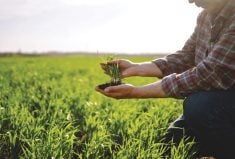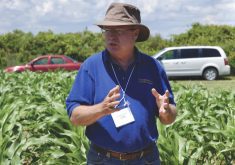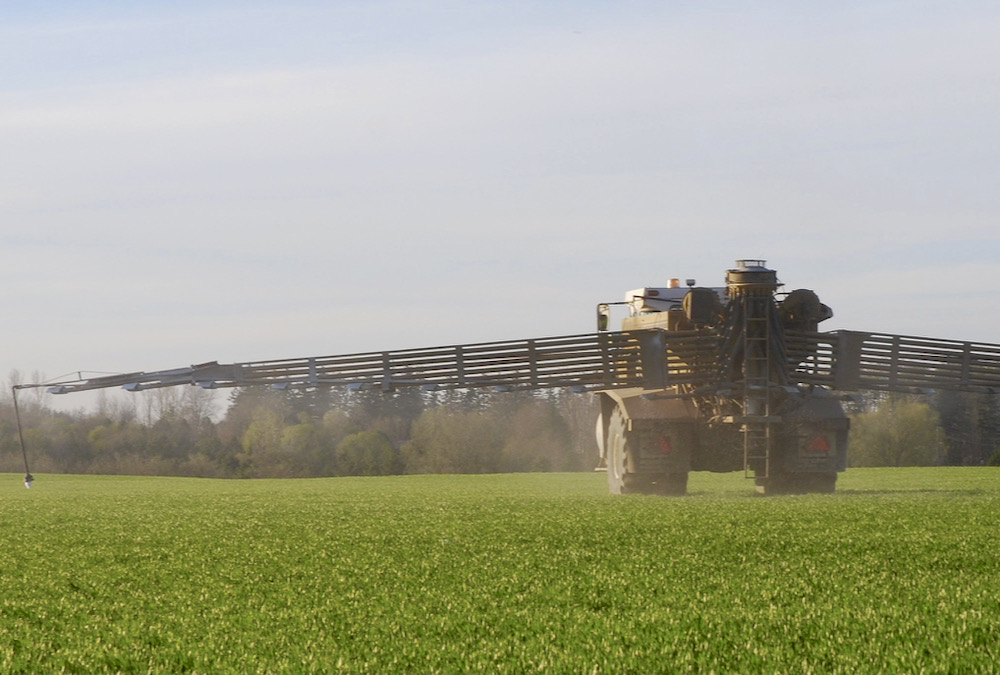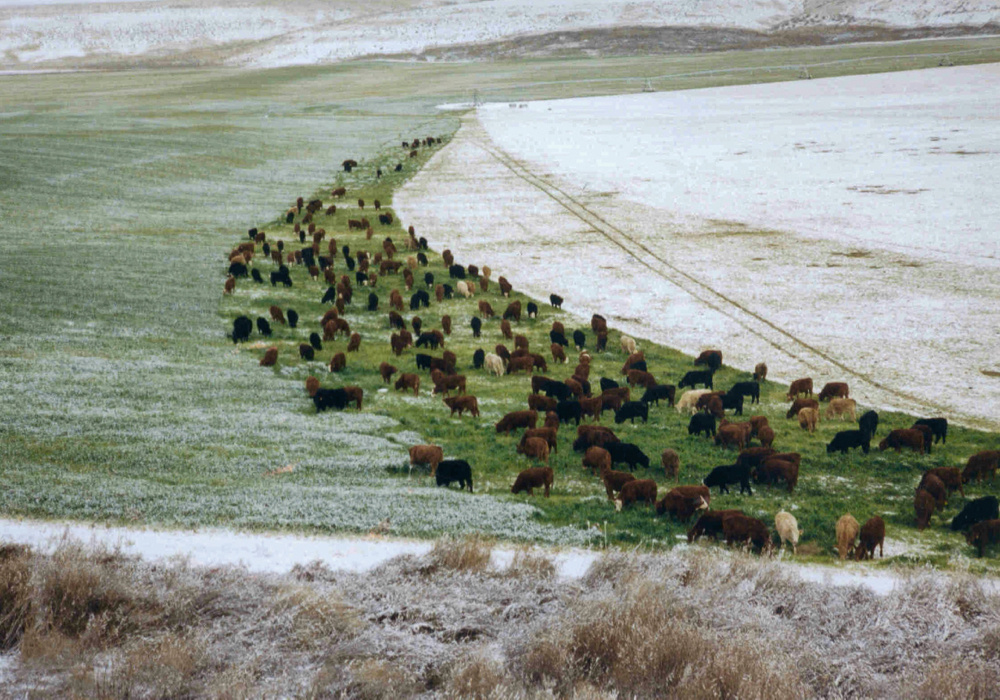The importance of carbon in agriculture has never been in scientific doubt. Whether it’s a component of photosynthesis — in the form of CO2 — or as part of the bigger picture carbon-nitrogen (C:N) ratio or the even more complicated carbon cycle, there’s no getting around the element’s value for farming.
That doesn’t mean we understand it, though.
Carbon is one of 16 elements labelled as essential for plant growth. Among the needed plant nutrients, it’s the first of three (along with hydrogen and oxygen) that are extracted by plants from the air and water. Between 94 and 99.5 per cent of plant material is composed of carbon, hydrogen and oxygen.
Read Also

Sensing the soil: Root cell research finds ‘stress hormone’
Research into how root cells react to soil stressors could help plants better adapt to changes in their climate.
The other slice is made up of all the other key elements, with the macronutrients (nitrogen, phosphorus, potassium, sulphur, calcium and magnesium) and the micronutrients (zinc, copper, iron, manganese, boron, chlorine and molybdenum) making up the other 0.5 to 6 per cent.
As important as carbon is to plant production, finding a cost-efficient method of extracting it from a viable source in order to add supplemental carbon is a real challenge. Among the companies that have launched ag-carbon initiatives, however, Lignition Corporation is early in the stage of examining the role of lignin and its applicability for crops.
According to president and co-owner Dave Sutherland, lignin is the most readily available source of what he calls harvestable sunlight. Yet lignin has little or no value to farmers and retailers within the current agricultural infrastructure. Lignin boasts a high carbon content — as much as 60 to 70 per cent — depending on the source. Canada’s forest and agricultural resources represent a phenomenal storehouse of energy — and it grows daily.
“Every farmer uses lignin already — or their crops would be flat on the ground,” says Sutherland, who has spent a number of growing seasons working with his wife, Lena, developing a process for deriving a useable form of lignin for use on a variety of crops in a variety of forms. “It’s in the stems, the leaves — it holds up the plant. It’s also in every field, as part of the carbon store in soil organic matter. It breaks down slowly, so it plays a key role in carbon and organic matter cycling.”
To prove Sutherland’s point, consider the biomass from a demonstration of stover harvest and baling equipment, hosted by La Coop fédérée, the Ontario Federation of Agriculture and BioIndustrial Innovation Canada in November 2014. The day’s proceedings included a presentation depicting the three components of stover that would be central to a proposed sugar processing plant targeted for somewhere in southern Ontario. Starch, cellulose and hemi-cellulose are the main ingredients being extracted from the stover; the lignin, along with the oil and protein from the corn, were excluded from the list of desirable traits — at least for this sugar processing plant.
Elemental sunlight
Yet Sutherland maintains that growers who ignore lignin’s importance stand to lose little — but yield. He cites a 2004 quote taken from a European journal, Industrial Crops and Products, which labelled lignin “one of the most abundant natural raw materials on earth, second to cellulose if mass is considered, (and) even first if solar energy storage is the criteria.”
Sutherland is currently in the very early stages of registering his process for extracting and deriving his carbon product for both Canada and the U.S., including trademarks on products for Canada, the U.S. and South America. He uses wheat straw and corn stover as some of his primary feedstocks, and has created 100 per cent soluble products and liquids. They can be applied directly to seeds, with or on fertilizers, as a foliar application or via aerial application.
“The benefits to the crop come from applying stored soluble sunlight that’s embedded in the lignin, by way of the photosynthetic process that grew the raw materials,” says Sutherland. “The early use of our products on seed or with the seed supports the process of plant growth or metabolic activation early, and the earlier the better.”
The soil also benefits from this process, typically through a larger root mass, which will store carbon as well as the exudates from the crop’s roots. The exudates represent added sugars generated from photosynthesis and also feed the micro-organisms in the soil.
Looking down the road, Sutherland believes there are applications for lignin product to enhance protein and mineral content in a crop. The drive, as always, is to grow bigger crops, but he sees a mandate of improving the quality at harvest as a goal that’s also worth pursuing.
“Some quality scores cannot be harvested as extra revenue directly by the grower,” says Sutherland, citing protein premiums in wheat as an example. “But this quality can be harvested in, let’s say, a livestock operation where higher protein and oil can be of a real (measurable) dollar value. We can also show the accumulated increase in crop growth and yield will remove a lot more CO2 from the atmosphere, which will become new biomass built on the carbon backbone.”
Trial results
Sutherland has done his due diligence on testing his product. Working with control corn plots of 200 bu./ac., he has seen consistent yield increases of 35 bu./ac. He’s also tried it with silage corn, and several other crops. Legumes respond well, he adds, with an ability to fix more nitrogen with an application of his lignin product. By increasing the photosynthetic sugars in the treated crop, the nodules are fed with more energy, so they can fix more nitrogen. In the process, yield, protein and/or oil may see an increase.
“We have good replicated data, plus split-field strip trials as well as peer-reviewed journal articles that support the approach we take,” Sutherland says. “Trials on corn, soybeans, winter and spring wheat, alfalfa, field pea, sugar beets, sunflowers and potatoes have been contracted. These are small-plot replicated trials, and we test for output gains, quality of output gains as well as input efficiency.”
In the time he’s been testing his “repurposed lignin” as he calls it, there have been no incompatibilities (chemical or physical) nor any phytotoxicities. The product can be tank mixed, keeping in mind that timing (be it during crop stage or plant growth) is the determining factor.
Interest is growing
Sutherland’s passion comes from the concept of environmental accountability, that is, using more of what’s already in the soil together with sustainable production and care for the medium in which our crops are grown — namely the soil. He’s read various books on the demise of past civilizations, with poor soil care as the primary culprit, and he believes we’re on much the same path right now. Where we differ from previous examples of food production collapse is in the level of atmospheric carbon dioxide that he believes to be the greatest challenge, but also an asset.
“Being able to capture more free solar energy (through the use of lignin) will increase crop photosynthetic activity and will also result in sequestering more carbon dioxide into the biosphere from the atmosphere,” says Sutherland. “That will help lower the impact of carbon on the world’s climate.”
Sutherland insists that doing all these things will also help ease concerns regarding food security and supply issues, as well as address feeding more people. By seeing those benefits, it would be possible to improve the efficient use of resources, and manage pollution and environmental loading (use of fertilizers).
“Photosynthesis is a very low-efficiency process, so when we raise the efficiency — which is our ultimate goal — everyone wins,” says Sutherland. “These products work on non-legumes, legumes plus C3 and C4 plants, annuals and perennials (including trees) and dry-land and irrigated crops — any green crop.”
At this point, Sutherland envisions the potential use of the lignin four or five times in any growing season. Depending on the crop, it could be used on the seed, as an in-furrow fertilizer treatment, as a side-dress treatment and/or a foliar application, with either one or two applications per season. Alfalfa might need up to five or six applications per season, depending on the growth or the number of cuts.
Replicated values
For several years, there have been repeated attempts to promote Canadian agriculture as a leader in carbon sequestration. There are even initiatives to entice growers to participate in cap-and-trade programs or other such ventures. Part of the problem is growers are reluctant to commit to such a project when commodity prices present such a difficult challenge as it is. Then there’s the matter of evaluating carbon, and extracting any such value.
Yet according to Dave and Lena Sutherland of Lignition Corporation, the process of calculating how much CO2 the corn crop in North America could drain from the atmosphere in a season is relatively simple. From there, another calculation can determine the value, either of the carbon extracted, or what’s in the ground. In 2013, Sutherland’s company participated in replicated trials, harvesting and measuring weights, percentage dry matter, protein as a percentage of dry matter and the percentage of carbon.
Its value is based loosely on the assumption that for every tonne of carbon in the crop biomass dry matter, the corn crop will remove or use up an estimated 3.67 tonnes of CO2 from the atmosphere (there is a formula from Monsanto that takes root growth and soil carbon into account). Using that data, it’s possible to calculate the value at $55 to $200 dollars per tonne of CO2. Sutherland concedes much of this is theoretical, but even if growers could capture value as carbon credits, they could sell those credits to a fertilizer company.
















